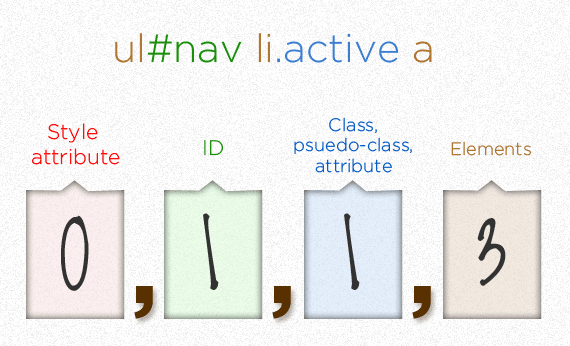There is a good amount of information on this site about specificity. The seminal one is Specifics on CSS Specificity, which has been updated a few times over the years. When it was originally published in 2008, it presented the information in a bit of a misleading way. It has long since been fixed, but the mistake is still interesting.
The original article showed specificity as an integer, so a selector like #main article.news p:first-child would have been listed as 0122 for the 1 ID, 2 classes, and 2 elements. The mistake? That makes it seem like a base-10 system. Say the specificity value was 0129 – if it was a base-10 system, adding one more element selector would make that 0130 which is definitely not what happens.
Jonathan Snook originally corrected me:
… if you had an element with 11 classes applied to it, it would not outrank an element with a single ID selector.
And Eric Meyer corroborated:
Specificity is not base-10. It’s not base-anything-familiar: in fact, specificity values have an infinite base.
(You can even find a broodling Harry Roberts in that comment thread!)
The trick with writing about specificity is to use commas so it doesn’t look like a single number. 0122 is better served as 0, 1, 2, 2. The diagrams in subsequent updated posts were better:

The first digit represents whether an element has an inline style or not, so that’s really just a 0 or a 1, but the rest are theoretically infinite. I guess it would be like this:
[0 or 1], ∞, ∞, ∞A number in a higher column can beat any number below. 0, 1, 0, 0 beats 0, 0, 312, 54659392. That right there is why it’s so popular to just never use ID’s and keep specificity flat.
++
Super update Chris! Just one quick thing.
“A number in a higher column can beat any number below. 0, 1, 0, 0 beats 0, 0, 312, 54659392”
This is nor really true for:
All versions on Internet Explorer
All version of Firefox
Google Chrome < 24
Safari OS X < 6.1
Safari iOS < 7
Android < 4.4
Where 256 classes wins with single ID.
I published a blog post about it the other day.
https://pawelgrzybek.com/css-specificity-explained/
That may be true in those versions but it was considered a bug, and in the real world, I doubt (hope) you would never run into a selector of 256 classes :)
I agree Brendan. That’s why I added note “totally useless” :) But “works”.
So that means specificity is base 256 (not including inline styles)?
I just noticed this today, but CSS Dig will actually split up specificity like this when you run it and check the “selectors” tab. It will also let you sort by specificity.
http://cssdig.com/
JustinTVizleHD
justintvizlehd sizlere en iyi ve maç keyfini sunuyor… Canlı lig tv izleyebileceğiniz, canlı maçları takip edebileceğiniz ve en önemlisi donmadan futbol keyfini hissedebileceğiniz eşsiz bir platformu sizlere sunuyor. canlı lig tv maçlarını en yüksek kalitede izlemenize de imkan sunuyor…
http://justintvizlehd.com/
Hi,
I’m using on my own site. it just my business. Thank you!
I’m using on my own site. it just my business. Thank you friend!
http://www.halilzafer.net/blog